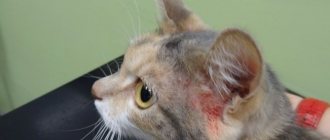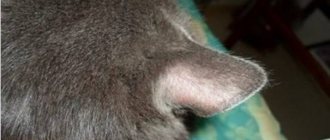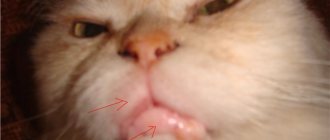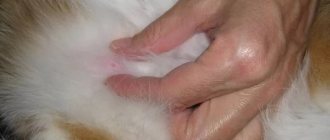Many cat owners sooner or later notice that their pet develops wounds or scratched areas on the skin. How to deal with such a problem?
The cat constantly tries to lick or scratch the wounded part of the skin. In such a situation, only a veterinarian can determine the cause of wounds or irritation. Sores in a cat’s neck should be immediately shown to a specialist, so as not to aggravate the situation with self-medication.
Most often, except in situations where the sore appears as a result of injury, any type of rash, bulge, redness of the skin or inflammation is a symptom of a disease that can seriously affect the condition of your furry pet.
The causes of diseases in cats can be determined by a veterinarian. As a rule, these can be:
- Parasites;
- Subcutaneous mite;
- Lichen;
- Eczema;
- Allergy;
Fleas sucking blood from your pets are one of the common causes of sores in cats, because these parasites irritate skin receptors. The animal scratches the bite sites, injuring the skin, and infection often penetrates into the damaged tissue - here you have weeping or festering sores.
Another dangerous parasite is the subcutaneous mite, which feeds on the product of the sebaceous glands, epidermal cells, and settles primarily on the animal’s neck, and then migrates to other parts of the body.
Lichen
This disease, which has many varieties, is caused by fungi of the Microsporum, Trichophiton or Epidermophiton species and affects the skin and hair follicles - and not only pets, but also humans. Here are the most common and dangerous types: pityriasis, red flat, pink and ringworm.
The clinical picture in case of lichen infection is as follows: skin lesions with rounded shapes or with uneven edges, accompanied by redness, itching, hair loss and peeling, occurring more often in the head, neck and extremities.
Without properly prescribed treatment, lichen spreads to other parts of the pet's body, and the affected skin can become inflamed and fester, and as a result, sores appear on it - this is due to a bacterial infection.
Only a correct diagnosis will help cure the animal and prevent serious complications.
Skin diseases: causes, symptoms, treatment and prevention
Microsporia There are so many skin diseases that affect cats that it is simply impossible to present all the available data about them in one article. However, there is a group of dermatological diseases that are most often diagnosed in these pets. It includes infections caused by various bacteria and fungi, pathologies caused by mites (demodex, otodectosis), lichen, psoriasis, acne, bedsores, allergies, bumps and other formations on the skin.
Dry form of bacterial infection
| Forms of bacterial infection | Symptoms | Treatment methods |
| Dry | Dense formations and crusts on the skin. | To eliminate signs of infection, depending on the clinical picture, the four-legged patient is prescribed oral antibacterial drugs (Amoxiclav, Cefoxitin, Clindamycin, Cephalexin) and topical agents (Miramistin, Levomekol, zinc ointment). Also, medicated shampoos (Api-San, Elite) are indicated for a sick pet. |
| Wet | Hyperemia and moisture in the affected areas of the epidermis, accompanied by rashes, the formation of ulcers and weeping crusts, and itching. |
Weeping eczema
| Types of lichen in cats | Symptoms | Treatment |
| Shearer |
|
|
| Pityriasis (multi-colored) |
| |
| Pink (not fungal etiology) |
|
|
| Weeping (eczema, caused by hormonal imbalance, stress, etc.) |
|
|
Ear mites
Fungi can also infect the outside of your pet's ear. Most often, otomycosis is caused by Aspergillus or Candida. This disease is accompanied by severe itching, redness, slight discharge of purulent exudate, and greenish-gray or pure gray deposits.
Damage by ticks
Demodectic mange in a cat
| Diseases caused by ticks | Symptoms | Treatment |
| Demodicosis |
|
|
| Otodectosis (ear mites) |
|
|
Psoriasis in a cat
Most veterinarians believe that felines do not get psoriasis. This is an exclusively human disease caused by specific factors of autoimmune origin. The scaling and itching that occurs on an animal's skin is a type of eczema. In any case, if some areas of your pet’s skin have dried out and begun to peel, these symptoms should not be ignored.
Lipoma on a cat's back
- Lipoma. This fatty tumor (wen) can appear anywhere. This benign neoplasm can increase in size, but does not have a tendency to metastasize. This formation is quite soft and painful. The appearance of a lipoma on the front or hind legs of an animal can lead to lameness, in the area of the carotid artery - to death as a result of suffocation. Most often, such formations, which must be removed surgically, are found in old pets.
Abscess treatment
- Abscess. It can develop after an unsuccessful injection or as a result of an insect bite. Abscess tumors are accompanied by pain, fever and increased local temperature. Such formations must be opened.
Inflammation of a lymph node in a cat
- Lymphadenitis. Characterized by inflammation of the lymph nodes. Inflamed lymph nodes are painful, but they are barely palpable. This type of formation is characterized by general intoxication of the pet’s body. Treatment of lymphadenitis depends on its cause and is based on the use of antibacterial, anti-inflammatory, hormonal, analgesic, antifungal drugs, as well as the use of physiotherapeutic methods.
- Encapsulation of a foreign object or source of bacterial infection. This formation is compacted and painless. Discomfort in a pet can only be caused by pressing on the lump. The general condition of the animal does not deteriorate. The foreign body is removed surgically.
Subcutaneous mite
- A mite that has burrowed under the skin. It is a small painless bump. It is recommended to contact a veterinarian to remove it.
Mastitis
- Mastitis or mastopathy. With such diseases, often accompanied by increased body temperature, lethargy, nausea, vomiting, loss of appetite, diarrhea, the bumps in females are localized in the nipple area. They are dense and painful. Mastitis in cats is treated with 10% calcium gluconate, 10% Catosal, Mastomethrin, Novocaine.
Cyst on a cat's head
- Cysts. Most often, the formation of capsules with serous contents does not affect the cat’s condition in any way. A pet can experience discomfort only when there is mechanical impact on a large lump. Typically, cysts are removed surgically.
Acne in a pet
Acne on a cat's chin
- black or white dots;
- partial hair loss in the affected areas;
- hard crusts.
This disease can provoke the appearance of painful ulcers and ulcers, against the background of which inflammation and infection can develop. To eliminate comedones, the affected areas are treated with antiseborrheic soap or shampoo, as well as antiseptic medications (Chlorhexidine, Miramistin). In advanced situations, antibacterial agents and corticosteroids are used to treat this disease.
The formation of bedsores, which are necrosis of soft tissues due to constant pressure, accompanied by local impairment of blood circulation and nervous trophism, is most susceptible to elderly pets and those who have recently suffered a serious injury or illness.
Bedsores are accompanied by:
- painful sensations when touched;
- a decrease in local temperature;
- ulcers;
- change in skin color.
This problem cannot be ignored. If it worsens, serious consequences may arise. Treatment consists of removing dead tissue, treating the affected areas with disinfectants and wound-healing ointments.
We suggest you familiarize yourself with: Ultrasonic mole repeller - Rating of the best models
Manifestations of allergies
Food allergy in a cat
This disease is a consequence of an inadequate reaction of the animal’s immune system to the entry of foreign agents - allergens - into its body. There are many reasons why a cat may develop allergies. The provoking factor can be any component of the feed, or pollen or perfume from the host. The disease manifests itself as:
- skin hyperemia;
- severe itching;
- partial baldness;
- increase in body temperature.
Eczema
Eczema affects the top layer of skin, causing redness, a rash, and then oozing blisters. All this causes itching in animals and scratching of inflamed skin. In the event of a bacterial infection, sores appear on areas of the skin affected by eczema - flaky and filled with pus.
In dogs, eczema most often affects the lumbar region, but gradually affects larger areas of the skin. If the process involves deeper layers of skin, then we will talk about dermatitis.
There are many causes of eczema: these are both external and internal factors. Eczema can be caused by diseases of internal organs and endocrine disorders. Therefore, it is so important that a correct diagnosis is made and adequate treatment is prescribed.
After all, no ointments can rid your pet of this insidious disease until you normalize the functioning of its internal organs.
Treatment
Once the cause of dermatitis is identified, appropriate therapy is prescribed. It is also worth considering information about medications taken if the cat is undergoing parallel treatment for some other diseases.
- To get rid of fleas, ticks and lice, preparations containing pyretin are used. Sulfur and Aversectin ointment, Advocate drops, Amit Forte show good results in practice. The affected areas of fur are cut off. In addition to ointments and aerosols, various baths, lotions and intramuscular injections can also be prescribed.
Important: one of the components of therapeutic therapy is measures to disinfect the animal’s area of residence.
- Ringworm is treated with products that contain fungicides. As in the case of skin parasites, it is necessary to pay special attention to disinfecting the premises where the animal lives, as well as to protect other pets from it.
- Food allergies are eliminated by eliminating potentially dangerous foods from the daily diet. Additionally, it is recommended to take antihistamines and agents that cleanse the body of toxins and intestinal parasites. In particular, we can talk about homeopathy and dietary supplements. Bathing with special shampoos is recommended.
- If a fungal or bacterial infection is detected, antibiotics are prescribed, the dosage regimen of which must strictly comply with medical prescriptions. Benadryl helps relieve itching.
- In case of autoimmune diseases, steroid drugs are used - analogues of Prednisone. Treatment often consists of several stages, when at the beginning the body receives large doses of the drug, and then its amount is progressively reduced.
As preventive measures, it is recommended to monitor the cleanliness of the cat’s dishes and litter box, monitor the quality of food and avoid “accidental” food. To avoid the risk of helminths, avoid raw foods (meat, fish). And, of course, regularly undergo scheduled examinations at the veterinary clinic.
Allergy
Pets are no less susceptible to allergies than people, and the causes may be the following: flea and tick saliva, food, antiparasitic drugs (sprays, shampoos, collars, etc.), household chemical products.
Sores on the neck most often appear in case of an allergy to antiparasitic agents applied to the withers area - an allergic reaction may occur at the site of contact with these substances. And already scratching the itchy area and complicating the damaged skin with concomitant infection leads to the appearance of ulcers and sores.
As you can see, similar symptoms can be caused by different reasons, and, therefore, treatment should be prescribed only after a thorough diagnosis.
Veterinary clinic doctors will not only find out the details of the medical history and examine the animal, but will also conduct the necessary research. This may include taking a skin scraping for culture, examination with a Wood's lamp, biochemical blood tests, ultrasound of internal organs, a hypoallergenic diet and other measures that help make an accurate diagnosis.
If fleas are present, the doctor will notice, most often on the neck, their excrement or eggs. Check the animal for lice and ear mites. He will rule out or confirm the presence of fungal spores and prescribe the necessary tests. And having identified the cause of the pain, he will prescribe the necessary treatment.
Often, sores on a cat's neck can appear due to scabies mites. This problem may be associated with a weakened immune system, communication with other infected animals, as well as feeding kittens from an already sick cat.
Another equally common cause of sores can be allergies. Food or chemical allergies cause red, itchy, and flaky skin. Allergies can be caused by dust, powders, and even tray filler.
Regular fleas can also contribute to the appearance of various diseases. It is better to prevent this problem by treating the cat with special anti-parasite products.
Causes of itching
Owners do not always immediately begin to sound the alarm when they discover scratching on their pet. Often they believe that this is not a very serious problem. If the scratching is minor and the itching does not particularly bother the cat, the owner can completely ignore this problem. But it is worth remembering that many diseases are curable only in the first stages. Therefore, it is important to promptly find out the cause of itching and provide professional help to your pet.
Lichen
This is an extremely contagious fungal disease that is also dangerous for humans. It is easily transmitted from a sick animal to a healthy one through short bodily contact, or even through grooming items (combs, nail clippers). Without timely treatment, lichen in dogs, like in cats, can lead to serious consequences for the health of the animal.
You may be interested in: A cat has blood in its stool: causes, treatment and prevention
The main symptoms of lichen infection:
- The coat appears unhealthy. A large number of broken hairs.
- Small bald spots appear, which the cat actively scratches. They can be found primarily on the head, neck and paws.
- Hard crusts appear on bald spots.
- Lost fur grows back very slowly.
- Dandruff appears on the skin.
- In the final stages, purulent lesions form.
Skin parasites
Fleas are a very common parasite, especially among cats that have free access to the outdoors. Fleas are quite dangerous, because their bites lead to a decrease in the animal’s immunity. The cat becomes vulnerable to various bacteria and fungi. Flea bites cause severe itching, causing the animal to constantly scratch. Particularly sensitive cats may scratch their skin until it bleeds.
Your cat can also pick up ticks, lice and coccidia. However, the animal does not have to go outside for this. The owner may well bring some parasites with him on shoes and clothes.
The main symptoms of infection with skin parasites:
- deterioration in the appearance of fur;
- severe itching;
- anxiety;
- fleas and ticks can be seen visually if you look closely at the animal’s skin.
A tick bite can lead to quite serious consequences. At the same time, the animal’s temperature may rise, loss of appetite, and decreased activity.
It is best to consult a veterinarian to remove a tick. If the procedure is performed incorrectly, parts of the tick may remain in the animal's skin, which can cause a purulent abscess to form.
Allergy
An allergic reaction can occur completely unexpectedly in any cat. Most often, animals suffer from food allergies. It often manifests itself when changing the diet or adding new foods to it. Food allergies are the easiest to identify and therefore easy to combat.
But when diagnosing non-food allergies, problems can arise. In this case, it is not always possible to determine which allergen caused the body’s negative reaction.
An allergic reaction can be caused by:
- individual food products (often chicken and milk);
- pollen and plant parts;
- flea and tick bites;
- various chemical elements contained in cleaning products and perfumes;
- dust.
Otitis
Otitis of the external ear is a serious disease that can cause many problems for the animal. Infection of the ear canals leads to inflammation. The cat constantly shakes its head and scratches its face until it bleeds.
The main symptoms of otitis in a cat:
- redness of the ear;
- anxiety;
- the cat constantly shakes its head;
- the animal scratches its ears and muzzle;
- increased body temperature;
- In the absence of timely treatment, pus may begin to leak from the auricle.
Worms
Even completely domestic cats are not immune from infection with worms. Parasite eggs can enter the animal's body through raw meat, unwashed hands, clothing, and grass. Infection with helminths leads to decreased immunity and disruption of the body.
The main symptoms of helminth infection:
- Deterioration in the appearance of the coat, scratching.
- Defecation disorder.
- The animal quickly loses weight.
- Itching in the area of the anus, which causes the animal to rub it on the floor and carpets.
- Decline in activity or, conversely, excessive anxiety.
- In advanced cases, severe shortness of breath occurs.
Bacterial diseases
Bacteria and fungi are found in small quantities on the skin of any cat. Usually, they do not cause any problems to the animal. But if the animal gets sick, its immunity is reduced, and the body is weakened, fungi and bacteria begin to actively multiply, which often leads to severe itching and scratching.
You might be interested in: A cat was bitten by a wasp: how and how to help your pet?
At risk are cats that already suffer from diabetes, allergies, and hyperthyroidism. This problem often occurs in kittens.
One of the most common bacterial infections in cats is pyoderma . Its main symptoms:
- severe itching;
- peeling of the skin;
- Scabs form on the wounds;
- baldness of certain areas of the skin;
- formation of purulent abscesses.
Pyoderma is very dangerous for cats. When the first symptoms appear, you should immediately consult a doctor.
Stress
All animals experience stressful situations differently. For some, moving or even ordinary fear can lead to not entirely adequate reactions. Constant licking of the same places may indicate mental disorders of the animal.
Of course, such a diagnosis can only be made after all other possible causes of itching have been excluded during the diagnostic process. The main symptoms of mental disorders and stress:
- refusal to eat;
- a decrease in activity or, conversely, excessive excitability;
- the animal constantly scratches or licks one place.
Breeds in which this problem most often occurs: Burmese, Orientals, Abyssinian and Siamese cats.
Disruption of hormone production
Disruption of the endocrine system leads to the appearance of various symptoms, including itching and scratching. A number of diseases that cause disruption of hormone production:
- Diabetes.
- Cushing's syndrome.
- Thyroid dysfunction.
Main symptoms:
- Hair loss and bald patches.
- Dryness and flaking of the skin.
- Severe itching and scratching.
How to treat neck pain
For correct treatment, you need to make a correct diagnosis. To do this, the veterinarian can take tests and examine the cat.
After the doctor makes a diagnosis, the four-legged pet is prescribed treatment. Depending on what exactly the problem is, treatment of neck sores may include local and general treatment.
Often the cat will need to be treated with antibiotics, and immunomodulators, anti-inflammatory or anti-parasitic drugs may also be used.
As soon as you notice sores on your cat’s neck, contact a veterinary clinic. Professional Bio-Vet doctors will provide the necessary assistance and help cure your pet.
Sores under a cat's fur: Symptoms
It can be difficult to notice any changes in the skin under a cat's fur, especially if it is thick and long. Groom your pet regularly - comb it. Then it will be easier to detect the problem at an early stage.
The owner may notice itching. Also, at the site of damage, the fur may fall off in shreds along with the crust. The skin may be red and have an unpleasant odor.
Seborrhea (dandruff) often occurs. You need to pay attention to all these signs and contact a veterinary dermatologist for diagnosis.
Watch the video: Fleas in cats - How to get rid of them, what medications to buy
Prices for appointments in our clinics
| Name of veterinary services | Unit | Price, rub |
| ⭐ Initial appointment | 1 animal | 400 |
| ⭐ Repeated appointment | 1 animal | 200 |
| Primary reception of ornamental, exotic animals, birds and reptiles | 1 animal | 1000 |
| Consultation without an animal | — | 500 |
| Consultation with a doctor based on test results | 1 PC. | 400 |










